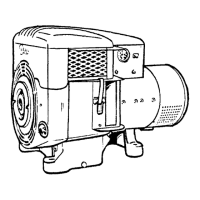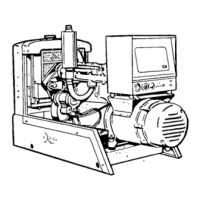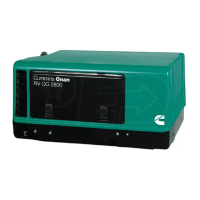light loads. Apply full load occasionally before shut-down
to
prevent excessive carbon accumulations.
Try to connect
the
load
in
steps
instead of full load
at
one time. Most installations use a line switch
that
must
be
closed
to
connect a portion of the load.
EXERCISE
STANDBY
SETS
Infrequent set
use
results
in
hard setting. Operate standby
set a
least
30
minutes
each
week.
Run
longer
if
battery
needs charging.
BREAK·IN
PROCEDURE
The unit should
be
run
in
the following sequence:
1.
One
half
hour at 1/2 load.
2. One half hour at
3/4
load.
3.
Full
load.
Continuous running under one half load during the first
few
hundred hours
usually.
results in poor piston ring
. seating, causing higher than normal oil consumption and
blowby.
MOTE:
Drain
the initial oil after SOhours
of
operation
while the engine
is
still hot.
SAFElY
DEVICES
In
case
of
dangerously high coolant (water) temperature or
low oil pressure,
the
cut-off switch stops the unit. After an
emergency stop, investigate and correct the
cause.
Press
re-set button before restarting.
EMERGENCY
OPERATION
IF
BATTERY
FAILS
MD
JF generating
sets
require a battery
for
running.
If
the
set battery
fails
completely and set must be operated during
an emergency, a battery can be shared
with
ether equipment
provided
the
set
charging circuit is disconnected
as
follows:
Remove the ammeter wire connected
to
terminal
No.8
in
the
cootro! box and tape the bare end. The
set
will not charge
the battery with
this
lead
wire
disconnected.
HEAT
EXCHANGER
(OPTIONAL)
FILLING
Improper filling of the heat exchanger can
cause
overheating·
of the e!lgine. Therefore, to prevent
this
possibility, follow
these
instructions whenever adding Icooling
to
the heat
exchanger:
1.
Remove fill cap.
2.
Open
fill vent valve (turn counterclockwise).
3. Remove vent plug, (Spec A through C).
4.
Fill
with
coolant.
5.
Close
fil.}
vent valve (turn clockwise).
6. Replace vent plug. (Spec A through C).
7. Replace fill cap.
8.
Operate unit 10 minutes at full load, watch
for
leaks.
9.
Shutdown unit.
After
running
unit
10
minates, the
closed cooling system
is
pressurized
and hot.
Open
the 14
lb.
preSSfJre
cap
slowly
to
vent
pressure.
10. Slowly open pressure cap and check water level.
11.
Fill
system to
top
with coolant.
OUT-Of·SERVICE
PROTECTION
When
taking unit out of service
for
30-days
or
longer, proper
storage methods must be used
to
prevent damage
from
cor-
rosion, contamination,
and
temperature extremes.
Fuel System
1.
Clean air cleaner
(if
used) -
do
not service air cleaner
with
oiL Check and clean air intake.
2.
Cover
or
seal exposed air intake openings.
3.
Clean throttle linkage (and governor linkage) thoroughly.
Lubricate metal ball
joints
with light machine oil (do
not lubricate plastic ball joints) .
Oil
System
1.
Drain engine lubricating oil while engine
is
warm.
Serv-
ice the engine with proper oil.
TAG
the engine
to
IDENTIFY the lubricating oil installed. Secure
the
oil
filter cap.
2. Remove fuel injectors. Pour 2 ounces of rust inhibitor
oil
(SAESO
substitute) into each cylinder. Crank e!lgine
over
by
hand several revolutions to lubricate cylinder
walls, pistons, and rings. Install injectors.
3.
Remove and service oil filter.
Cooling System
1.
Drain entire cooling system including water cooled ex-
haust manifold and exhaust line. Drain heat exchanger
or
keel cooler components, engine cylinder block, and
water pumps.
Senerating units equipped with heat exchanger or keel
cooling
may
be filled with a
good
quality anti-freeze if
freezing temperatures are expected. Drain only those
components not protected
from
freezing (exhaust lines,
water intake and outlet lines, etc.).
19

